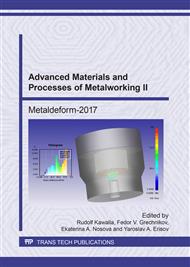[1]
M. Acarer, Electrical, corrosion, and mechanical properties of aluminum-copper joints produced by explosive welding, Journal of Materials Engineering and Performance, 21 (2012) 2375–2379.
DOI: 10.1007/s11665-012-0203-6
Google Scholar
[2]
B.N. Mordyuk, G.I. Prokopenko, Ultrasonic impact peening for the surface properties' management, Journal of Sound and Vibration. 308 (2007) 855-866.
DOI: 10.1016/j.jsv.2007.03.054
Google Scholar
[3]
B. Crossland, A.S. Bahrani, Fundamentals, of explosive welding, Contemporary Physics. 9 (1968) 71–87.
DOI: 10.1080/00107516808204394
Google Scholar
[4]
P. Manikandan, K. Hokamoto, M. Fujita, K. Raghukandan, R. Tomoshige, Control of energetic conditions by employing interlayer of different thickness for explosive welding of titanium/304 stainless steel, Journal of Materials Processing Technology. 195 (2008).
DOI: 10.1016/j.jmatprotec.2007.05.002
Google Scholar
[5]
V.V. Rybin, N.Y. Zolotorevskii, E.A. Ushanova, Analysis of the misoriented structures in the model copper-copper compound formed by explosion welding, Technical Physics, 59 (2014) 1819-1832.
DOI: 10.1134/s106378421412024x
Google Scholar
[6]
W. -L. Dai, Effects of high-intensity ultrasonic-wave emission on the weldability of aluminum alloy 7075-T6, Materials Letters. 57 (2003) 2447-2454.
DOI: 10.1016/s0167-577x(02)01262-4
Google Scholar
[7]
M. Carboni, F. Moroni, Tensile-shear fatigue behavior of aluminum and magnesium lap-joints obtained by ultrasonic welding and adhesive bonding, Procedia Engineering. 10 (2011) 3561-3566.
DOI: 10.1016/j.proeng.2011.04.586
Google Scholar
[8]
A.P. Peev, S.V. Kuz'min, V.I. Lysak, E.V. Kuz'min, A.N. Dorodnikov, Structure and properties of joints produced by ultrasound-assisted explosive welding, The Physics of Metals and Metallography. 116 (2015) 817–822.
DOI: 10.1134/s0031918x1508013x
Google Scholar
[9]
V.I. Lysak, S.V. Kuzmin, Energy balance during explosive welding, Journal of Materials Processing Technology. 222 (2015) 356-364.
DOI: 10.1016/j.jmatprotec.2015.03.024
Google Scholar
[10]
V.I. Lysak, S.V. Kuzmin, Lower boundary in metal explosive welding. Evolution of ideas, Journal of Materials Processing Technology. 212 (2012) 150-156.
DOI: 10.1016/j.jmatprotec.2011.08.017
Google Scholar
[11]
M.M. Hoseini Athar, B.L. Tolaminejad, Weldability window and the effect of interface morphology on the properties of Al/Cu/Al laminated composites fabricated by explosive welding, Materials and Design. 86 (2015) 516–525.
DOI: 10.1016/j.matdes.2015.07.114
Google Scholar
[12]
Yu.A. Gordopolov, A.N. Dremin, A.N. Mikhailov, Theory of waves on the interface of metals welded by explosion, Combustion, Explosion, and Shock Waves. 14 (1978) 472-480.
DOI: 10.1007/bf00742954
Google Scholar
[13]
S.K. Godunov, A.A. Deribas, N.S. Kozin, Wave formation in explosive welding, Journal of Applied Mechanics and Technical Physics, 12 (1973) 398-406.
DOI: 10.1007/bf00851622
Google Scholar
[14]
J.Z. Ashani, S.M. Bagheri, Explosive scarf welding of aluminum to copper plates and their interface properties, Materialwissenschaft und Werkstofftechnik, 40 (2009) 690-698.
DOI: 10.1002/mawe.200900415
Google Scholar
[15]
B. Gulenc, Investigation of interface properties and weldability of aluminum and copper plates by explosive welding method, Materials and Design, 29 (2008), 275-278.
DOI: 10.1016/j.matdes.2006.11.001
Google Scholar
[16]
M.P. Bondar', V.M. Ogolikhin, Plastic deformation and bond formation during explosive welding of copper plates, Combustion, Explosion, and Shock Waves, 24 (1988) 113-117.
DOI: 10.1007/bf00749085
Google Scholar


